Mapping the In-Motion Emotional Urban Experiences: An Evidence-Based Method
Abstract
1. Introduction
2. Method
2.1. Case Study
2.2. The Experiential Walk: Materials & Measures
- The “Trifoglio area” is an open university space below the street level recently renovated (https://www2.polimi.it/il-politecnico/progetti-di-ateneo/nuovo-campus-architettura.html (last accessed on 11 March 2023)) (2021) based on the design concept of Renzo Piano and developed by the ODB-OTTAVIO DI BLASI & Partners architecture office. Today, it has a hard pavement and sits with some trees, and is encompassed by the university buildings; it is used by students to rest and meet during the day; the sight is directed east toward (from the right side) the buildings of the School of Architecture “Building 13—Trifoglio” by Gio Ponti in 1963, “Building 11—Architecture” by Vittoriano Viganò in 1985, the Department of Architecture and Urban Studies “Building 12—Cesare Chiodi” of 1962 (Figure 4).
- Leonardo Da Vinci square was one of the relevant outcomes of the CSCS project (https://www.labsimurb.polimi.it/piazza-leonardo-da-vinci-renewal/ (last accessed on 11 March 2023)). It was renovated in 2016 based on the design project by Sara Protasoni and in collaboration with the Municipality of Milan passing from a parking area to a people-centered place (Figure 5); today it is mainly a pedestrian area characterized by a large path with benches and big green zones where students stay to rest and socialize; the view is oriented to spot the historic main building (1927) of the Rectorate (“Building 1—the Rectorate”);
- 3.
- The “Rectorate area” is the core area of the historical university block built in 1927; this area was recently renovated (2019) based on the design project “Giardini di Leonardo” [Leonardo’s gardens] under the direction of Emilio Faroldi and within the framework of the VIVIPOLIMI project, aiming at improving the campus livability by increasing green and public areas and reducing parking slots. The area is characterized by a central garden and several fixed benches and tables; it is always full of students chatting or studying. Standing on the north-west corner of the garden, participants looked south-east in the direction of the green area; it is important to notice that on the day of the walk there was a functioning building site impacting the functionalities and atmosphere of the place, in particular the green area surrounded by a white and red stripe to block people access (Figure 6).
- 4.
- The stop is in Ponzio Street that is right outside the gates of the historical POLIMI block and connects two parts of the POLIMI campus. During working days the road is usually highly trafficked. Despite the structure of a boulevard, with a large section, two-directions carriages and large trees on both sides, pedestrians mainly use it to reach rapidly the POLIMI entrance, and it is otherwise used as a parking area, both on the street and under the trees. The stop was before crossing the street, on the sidewalk where the zebra crossing starts; the crossing is not regulated by a traffic light and the view is oriented North towards the approaching cars (Figure 7).
- 5.
- The stop is located in the middle of Pascal Street, a private POLIMI road that is mainly used as a parking area by the staff working at POLIMI. Some buildings are on both sides of the road, mainly POLIMI Departments, the Besta hospital, and the “Mario Giuriati” sport camp; the stop is in front of the entrance of the Giuriati building and the recently renovated (2018) “Building 20” hosting the Department of Electronics, Information and Bioengineering; the view is aligned to the street axis and looks East (Figure 8).
- 6.
- Last stop is on Golgi Street, leading to the eastern and last blocks of both POLIMI and UNIMI universities. This is a two-way urban street highly trafficked in working hours. It has large sidewalks without trees and is mainly surrounded by universities and schools; on the West side a long blind wall runs along the sport camp. There are no dedicated spaces for socialization, no benches and no commercial activities in the portion of the street explored with the participants and there are no green areas except for a spot area with grass, not well maintained, on the left side of the stop (Figure 9).
2.3. Participants
2.4. Procedure
- Day one (1) short introduction to the activity; (2) APP installation and registration (3) preliminary groups and teams’ organization; (4) experiential walk and data collection via the APP through preselected stops; (5) class workshop (debriefing); (6) sharing and first discussion of the debriefing outcomes.
- Day two (7) theoretical lecture on environmental psychology for urban design; (8) presentation and discussion of the data analysis outcomes.
- Day three (9) students’ presentation of the experiential walk interpretation.
2.5. Analyses
3. Results
3.1. Descriptive Analysis
3.1.1. Sample
3.1.2. Città Studi Neighborhood: Emotional Appraisal and Familiarity
3.1.3. Clustered Emotional Appraisal: Analysis of the Data Collected via the Mobile App
3.1.4. Clustered Emotional Appraisal (Direct Participants’ Feedback)
3.2. Inferential Analysis
4. Discussion and Conclusions
5. Patents
Author Contributions
Funding
Institutional Review Board Statement
Informed Consent Statement
Data Availability Statement
Conflicts of Interest
References
- Moudon, A.V. “A Catholic Approach to Organizing What Urban Designers Should Know”: From Journal of Planning Literature (1992). In The Urban Design Reader; Routledge: London, UK, 2012; ISBN 978-0-203-09423-5. [Google Scholar]
- Carmona, M. The Place-Shaping Continuum: A Theory of Urban Design Process. J. Urban Des. 2014, 19, 2–36. [Google Scholar] [CrossRef]
- Ellard, C. Neuroscience, Wellbeing, and Urban Design: Our Universal Attraction to Vitality. Psychol. Res. Urban Soc. 2020, 3, 6. [Google Scholar] [CrossRef]
- Thibaud, J.-P. The Backstage of Urban Ambiances: When Atmospheres Pervade Everyday Experience. Emot. Space Soc. 2015, 15, 39–46. [Google Scholar] [CrossRef]
- Augustin, S. Place Advantage: Applied Psychology for Interior Architecture; John Wiley & Sons, Inc.: Hoboken, NJ, USA, 2009; ISBN 978-0-470-42212-0. [Google Scholar]
- Lang, J.T. Urban Design: A Typology of Procedures and Products; Elsevier: Amsterdam, The Netherlands, 2005; ISBN 978-0-7506-6628-2. [Google Scholar]
- Salama, A.M. Spatial Design Education: New Directions for Pedagogy in Architecture and Beyond; Routledge: London, UK, 2015; p. 385. [Google Scholar]
- Salama, A.M. Knowledge and Design: People-Environment Research for Responsive Pedagogy and Practice. Procedia—Soc. Behav. Sci. 2012, 49, 8–27. [Google Scholar] [CrossRef]
- Nisha, B. The Pedagogic Value of Learning Design with Virtual Reality. Educ. Psychol. 2019, 39, 1233–1254. [Google Scholar] [CrossRef]
- Böhme, G. Atmosphere as the Fundamental Concept of a New Aesthetics. Thesis Elev. 1993, 36, 113–126. [Google Scholar] [CrossRef]
- Bille, M.; Simonsen, K. Atmospheric Practices: On Affecting and Being Affected. Space Cult. 2021, 24, 295–309. [Google Scholar] [CrossRef]
- Bille, M.; Bjerregaard, P.; Sørensen, T.F. Staging Atmospheres: Materiality, Culture, and the Texture of the in-Between. Emot. Space Soc. 2015, 15, 31–38. [Google Scholar] [CrossRef]
- Carmona, M.; Tiesdell, S.; Heath, T.; Oc, T. Public Places, Urban Spaces: The Dimensions of Urban Design; Routledge: London, UK, 2010; ISBN 978-1-85617-827-3. [Google Scholar]
- Piga, B.E.A. Experiential-Walk. Experiencing and Representing the City for Urban Design Purposes. In Experiential Walks for Urban Design. Revealing, Representing, and Activating the Sensory Environment; Piga, B.E.A., Siret, D., Thibaud, J.-P., Eds.; Springer International Publishing: Cham, Switzerland, 2021; pp. 1–19. ISBN 978-3-030-76694-8. [Google Scholar]
- Experiential Walks for Urban Design. Revealing, Representing, and Activating the Sensory Environment; Piga, B.E.A., Siret, D., Thibaud, J.-P., Eds.; Springer Tracts in Civil Engineering; Springer International Publishing: Cham, Switzerland, 2021; ISBN 978-3-030-76693-1. [Google Scholar]
- Berry, L.L.; Parker, D.; Coile, R.C., Jr.; Hamilton, D.K.; O’Neill, D.D.; Sadler, B.L.J. The Business Case for Better Buildings. Front. Health Serv. Manag. 2004, 21, 3–24. [Google Scholar] [CrossRef]
- Hamilton, D.K.; Watkins, D.H. Evidence-Based Design for Multiple Building Types; John Wiley & Sons: Hoboken, NJ, USA, 2008; p. 261. ISBN 978-0-470-12934-0. [Google Scholar]
- Ulrich, R.S. Essay: Evidence-Based Health-Care Architecture. Lancet 2006, 368, S38–S39. [Google Scholar] [CrossRef]
- Ulrich, R.S.; Zimring, C.; Zhu, X.; DuBose, J.; Seo, H.-B.; Choi, Y.-S.; Quan, X.; Joseph, A. A Review of the Research Literature on Evidence-Based Healthcare Design. HERD Health Environ. Res. Des. J. 2008, 1, 61–125. [Google Scholar] [CrossRef] [PubMed]
- Sailer, K.; Budgen, A.; Lonsdale, N.; Turner, A.; Penn, A. Evidence-Based Design: Theoretical and Practical Reflections of an Emerging Approach in Office Architecture. In Proceedings of the Undisciplined—DRS International Conference 2008, Sheffield, UK, 16–19 July 2008; p. 20. [Google Scholar]
- Davoodi, A.; Johansson, P.; Aries, M. The Use of Lighting Simulation in the Evidence-Based Design Process: A Case Study Approach Using Visual Comfort Analysis in Offices. Build. Simul. 2020, 13, 141–153. [Google Scholar] [CrossRef]
- Lippman, P.C. Evidence-Based Design of Elementary and Secondary Schools: A Responsive Approach to Creating Learning Environments; John Wiley & Sons: Hoboken, NJ, USA, 2010; ISBN 978-0-470-91593-6. [Google Scholar]
- Kilbourne, J.R.; Scott-Webber, L.; Kapitula, L.R. An Activity-Permissible Classroom: Impacts of an Evidence-Based Design Solution on Student Engagement and Movement in an Elementary School Classroom. Child. Youth Environ. 2017, 27, 112–134. [Google Scholar] [CrossRef]
- Fisher, K.; Newton, C. Transforming the Twenty-First-Century Campus to Enhance the Net-Generation Student Learning Experience: Using Evidence-Based Design to Determine What Works and Why in Virtual/Physical Teaching Spaces. High. Educ. Res. Dev. 2014, 33, 903–920. [Google Scholar] [CrossRef]
- Chen, Z.; Schulz, S.; Qiu, M.; Yang, W.; He, X.; Wang, Z.; Yang, L. Assessing Affective Experience of In-Situ Environmental Walk via Wearable Biosensors for Evidence-Based Design. Cogn. Syst. Res. 2018, 52, 970–977. [Google Scholar] [CrossRef]
- Gramkow, M.C.; Sidenius, U.; Zhang, G.; Stigsdotter, U.K. From Evidence to Design Solution—On How to Handle Evidence in the Design Process of Sustainable, Accessible and Health-Promoting Landscapes. Sustainability 2021, 13, 3249. [Google Scholar] [CrossRef]
- Fisher, T. Architects Behaving Badly. Ignoring Environmental Behavior Research. Harv. Des. Mag. 2004, 21, 1–3. [Google Scholar]
- Chong, G.H.; Brandt, R.; Martin, W.M. Design Informed: Driving Innovation with Evidence-Based Design; John Wiley & Sons: Hoboken, NJ, USA, 2010; ISBN 978-0-470-91640-7. [Google Scholar]
- Bonnes, M.; Scopelliti, M.; Fornara, F.; Carrus, G. Urban Environmental Quality. In Environmental Psychology; John Wiley & Sons, Ltd.: Hoboken, NJ, USA, 2018; pp. 113–122. ISBN 978-1-119-24107-2. [Google Scholar]
- Boffi, M.; Rainisio, N. To Be There, or Not to Be. Designing Subjective Urban Experiences. In Urban Design and Representation; Springer International Publishing: Cham, Switzerland, 2017; pp. 37–53. [Google Scholar]
- Devine-Wright, P. Beyond NIMBYism: Towards an Integrated Framework for Understanding Public Perceptions of Wind Energy. Wind Energy 2005, 8, 125–139. [Google Scholar] [CrossRef]
- Bonaiuto, M.; Fornara, F.; Bonnes, M. Perceived Residential Environment Quality in Middle- and Low-Extension Italian Cities. Eur. Rev. Appl. Psychol. 2006, 56, 23–34. [Google Scholar] [CrossRef]
- White, E.V.; Gatersleben, B. Greenery on Residential Buildings: Does It Affect Preferences and Perceptions of Beauty? J. Environ. Psychol. 2011, 31, 89–98. [Google Scholar] [CrossRef]
- Hartig, T.; Evans, G.W.; Jamner, L.D.; Davis, D.S.; Gärling, T. Tracking Restoration in Natural and Urban Field Settings. J. Environ. Psychol. 2003, 23, 109–123. [Google Scholar] [CrossRef]
- Ulrich, R.S.; Simons, R.F.; Losito, B.D.; Fiorito, E.; Miles, M.A.; Zelson, M. Stress Recovery during Exposure to Natural and Urban Environments. J. Environ. Psychol. 1991, 11, 201–230. [Google Scholar] [CrossRef]
- Russell, J.A.; Lanius, U.F. Adaptation Level and the Affective Appraisal of Environments. J. Environ. Psychol. 1984, 4, 119–135. [Google Scholar] [CrossRef]
- Russell, J.A.; Pratt, G. A Description of the Affective Quality Attributed to Environments. J. Pers. Soc. Psychol. 1980, 38, 311–322. [Google Scholar] [CrossRef]
- Dazkir, S.S.; Read, M.A. Furniture Forms and Their Influence on Our Emotional Responses Toward Interior Environments. Environ. Behav. 2012, 44, 722–732. [Google Scholar] [CrossRef]
- Ko, W.H.; Schiavon, S.; Zhang, H.; Graham, L.T.; Brager, G.; Mauss, I.; Lin, Y.-W. The Impact of a View from a Window on Thermal Comfort, Emotion, and Cognitive Performance. Build. Environ. 2020, 175, 106779. [Google Scholar] [CrossRef]
- Baloglu, S.; Brinberg, D. Affective Images of Tourism Destinations. J. Travel Res. 1997, 35, 11–15. [Google Scholar] [CrossRef]
- Lee, A.H.; Denizci Guillet, B.; Law, R. Tourists’ Emotional Wellness and Hotel Room Colour. Curr. Issues Tour. 2018, 21, 856–862. [Google Scholar] [CrossRef]
- Park, S.B.; Kim, J.; Lee, Y.K.; Ok, C.M. Visualizing Theme Park Visitors’ Emotions Using Social Media Analytics and Geospatial Analytics. Tour. Manag. 2020, 80, 104127. [Google Scholar] [CrossRef]
- Weidmann, S.; Filep, S.; Lovelock, B. Promoting the Thrills: A Study of Emotional Reactions to Advertisements for Fright Tourism Heritage Attractions. J. Herit. Tour. 2023, 1–20. [Google Scholar] [CrossRef]
- Churchman, A. Environmental Psychology and Urban Planning: Where Can the Twain Meet. In Handbook of Environmental Psychology; John Wiley & Sons: Hoboken, NJ, USA, 2002; ISBN 978-0-471-18847-6. [Google Scholar]
- Li, X.; Hijazi, I.; Koenig, R.; Lv, Z.; Zhong, C.; Schmitt, G. Assessing Essential Qualities of Urban Space with Emotional and Visual Data Based on GIS Technique. ISPRS Int. J. Geo-Inf. 2016, 5, 218. [Google Scholar] [CrossRef]
- Rachuri, K.K.; Musolesi, M.; Mascolo, C.; Rentfrow, P.J.; Longworth, C.; Aucinas, A. EmotionSense: A Mobile Phones Based Adaptive Platform for Experimental Social Psychology Research. In Proceedings of the 12th ACM International Conference on Ubiquitous Computing, Copenhagen, Denmark, 26 September 2010; Association for Computing Machinery: New York, NY, USA, 2010; pp. 281–290. [Google Scholar]
- Burns, A. Emotion and Urban Experience: Implications for Design. Des. Issues 2000, 16, 67–79. [Google Scholar] [CrossRef]
- Balducci, A.; Fedeli, V.; Longo, A.; Medina, T.; Morello, E.; Piga, B.E.A. Città Studi Cambia. Un laboratorio Delle Idee e Dell’immaginario Scientifico e Urbano; Politecnico di Milano: Comune di Milano, Italy, 2017; pp. 1–119. [Google Scholar]
- Morello, E.; Piga, B.E.A. Envisioning the Sustainable Campus: The Urban Model as the Hub That Supports the Transformation. In Proceedings of the Envisioning Architecture: Design, Evaluation, Communication—Proceedings of the 11th Conference of the European Architectural Envisioning Association, Milan, Italy, 25–28 September 2013; pp. V–XI. [Google Scholar]
- Piga, B.E.A.; Morello, E.; Signorelli, V. The Combined Use of Urban Models to Support a Collaborative Approach to Design Towards the Sustainable University Campus: Participation, Design, Transformation. In Proceedings of the Design & Graphic Palimpsest: Dialogue, Discourse, Discussion; Uddin, S.M., Welty, C., Eds.; Southern Polytechnic State University: Marietta, GA, USA, 2014; pp. 53–58. [Google Scholar]
- Piga, B.E.A.; Rainisio, N.; Boffi, M. The Experiential Walk Diary. Mapping Urban Experience Combining Architecture and Psychology. Urban Inf. 2020, 289, 14–18. [Google Scholar]
- Piga, B.E.A.; Stancato, G.; Rainisio, N.; Boffi, M. How Do Nature-Based Solutions’ Color Tones Influence People’s Emotional Reaction? An Assessment via Virtual and Augmented Reality in a Participatory Process. Sustainability 2021, 13, 13388. [Google Scholar] [CrossRef]
- Piga, B.E.A.; Stancato, G.; Boffi, M.; Rainisio, N. Emotional Clustered Isovist. Representing the Subjective Urban Experience. In Proceedings of the Envisioning Architectural Narratives: Monograph of the 15th Biennial International Conference of the European Architectural Envisioning Association, Huddersfield, UK, 3 September 2021; Di Mascio, D., Ed.; The University of Huddersfield: Huddersfield, UK, 2021; pp. 163–173. [Google Scholar]
- Boffi, M.; Pola, L.G.; Fermani, E.; Senes, G.; Inghilleri, P.; Piga, B.E.A.; Stancato, G.; Fumagalli, N. Visual Post-Occupancy Evaluation of a Restorative Garden Using Virtual Reality Photography: Restoration, Emotions, and Behavior in Older and Younger People. Front. Psychol. 2022, 13, 927688. [Google Scholar] [CrossRef]
- Bradley, M.M.; Lang, P.J. Measuring Emotion: The Self-Assessment Manikin and the Semantic Differential. J. Behav. Ther. Exp. Psychiatry 1994, 25, 49–59. [Google Scholar] [CrossRef]
- Betella, A.; Verschure, P.F.M.J. The Affective Slider: A Digital Self-Assessment Scale for the Measurement of Human Emotions. PLoS ONE 2016, 11, e0148037. [Google Scholar] [CrossRef]
- Birant, D.; Kut, A. ST-DBSCAN: An Algorithm for Clustering Spatial–Temporal Data. Data Knowl. Eng. 2007, 60, 208–221. [Google Scholar] [CrossRef]
- McInnes, L.; Healy, J.; Astels, S. Hdbscan: Hierarchical Density Based Clustering. J. Open Source Softw. 2017, 2, 205. [Google Scholar] [CrossRef]
- Malzer, C.; Baum, M. A Hybrid Approach To Hierarchical Density-Based Cluster Selection. In Proceedings of the 2020 IEEE International Conference on Multisensor Fusion and Integration for Intelligent Systems (MFI), Karlsruhe, Germany, 14–16 September 2020; IEEE: Karlsruhe, Germany, 2020; pp. 223–228. [Google Scholar]
- Strasburger, H.; Rentschler, I.; Jüttner, M. Peripheral Vision and Pattern Recognition: A Review. J. Vis. 2011, 11, 13. [Google Scholar] [CrossRef]
- Pallasmaa, J. The Eyes of the Skin: Architecture and the Senses; Academy Editions: London UK; Lanham, MD, USA, 1996; ISBN 1-85490-439-6. [Google Scholar]
- Fumagalli, N.; Fermani, E.; Senes, G.; Boffi, M.; Pola, L.; Inghilleri, P. Sustainable Co-Design with Older People: The Case of a Public Restorative Garden in Milan (Italy). Sustainability 2020, 12, 3166. [Google Scholar] [CrossRef]
- Thibaud, J.-P. The Sensory Fabric of Urban Ambiances. Senses Soc. 2011, 6, 203–215. [Google Scholar] [CrossRef]
- Piga, B.E.A.; Morello, E. Environmental Design Studies on Perception and Simulation: An Urban Design Approach. Int. J. Sens. Environ. Archit. Urban Space 2015. [Google Scholar] [CrossRef]
- Sepe, M. Placemaking, Livability and Public Spaces. Achieving Sustainability through Happy Places. J. Public Space 2017, 2, 63. [Google Scholar] [CrossRef]
- Weijs-Perrée, M.; Dane, G.; Van Den Berg, P. Analyzing the Relationships between Citizens’ Emotions and Their Momentary Satisfaction in Urban Public Spaces. Sustainability 2020, 12, 7921. [Google Scholar] [CrossRef]
- Peters, T.; D’Penna, K. Biophilic Design for Restorative University Learning Environments: A Critical Review of Literature and Design Recommendations. Sustainability 2020, 12, 7064. [Google Scholar] [CrossRef]
- Kjellgren, A.; Buhrkall, H. A Comparison of the Restorative Effect of a Natural Environment with That of a Simulated Natural Environment. J. Environ. Psychol. 2010, 30, 464–472. [Google Scholar] [CrossRef]
- Gehl, J.; Gehl, J. Life between Buildings: Using Public Space; Island Press: Washington, DC, USA, 2011; ISBN 978-1-59726-827-1. [Google Scholar]
- Bowler, D.E.; Buyung-Ali, L.M.; Knight, T.M.; Pullin, A.S. A Systematic Review of Evidence for the Added Benefits to Health of Exposure to Natural Environments. BMC Public Health 2010, 10, 456. [Google Scholar] [CrossRef]
- Han, K.-T.; Ruan, L.-W. Effects of Indoor Plants on Self-Reported Perceptions: A Systemic Review. Sustainability 2019, 11, 4506. [Google Scholar] [CrossRef]
- Lachowycz, K.; Jones, A.P. Towards a Better Understanding of the Relationship between Greenspace and Health: Development of a Theoretical Framework. Landsc. Urban Plan. 2013, 118, 62–69. [Google Scholar] [CrossRef]
- McMahan, E.A.; Estes, D. The Effect of Contact with Natural Environments on Positive and Negative Affect: A Meta-Analysis. J. Posit. Psychol. 2015, 10, 507–519. [Google Scholar] [CrossRef]
- Mcsweeney, J.; Rainham, D.; Johnson, S.A.; Sherry, S.B.; Singleton, J. Indoor Nature Exposure (INE): A Health-Promotion Framework. Health Promot. Int. 2015, 30, 126–139. [Google Scholar] [CrossRef] [PubMed]
- Bogerd, N.V.D.; Dijkstra, S.C.; Seidell, J.; Maas, J. Greenery in the University Environment: Students’ Preferences and Perceived Restoration Likelihood. PLoS ONE 2018, 13, e0192429. [Google Scholar] [CrossRef]
- Kim, D.-Y.; Wen, L.; Doh, K. Does Cultural Difference Affect Customer’s REsponse in a Crowded Restaurant Environment? A Comparison of American versus Chinese Customers. J. Hosp. Tour. Res. 2010, 34, 103–123. [Google Scholar] [CrossRef]
- Pons, F.; Mourali, M.; Giroux, M. The Density–Satisfaction Relationship Revisited: The Role of Scarcity and Consumers Affective Reactions in a Crowded Retail Situation. J. Retail. Consum. Serv. 2014, 21, 54–60. [Google Scholar] [CrossRef]
- Bornioli, A.; Subiza-Pérez, M. Restorative Urban Environments for Healthy Cities: A Theoretical Model for the Study of Restorative Experiences in Urban Built Settings. Landsc. Res. 2023, 48, 152–163. [Google Scholar] [CrossRef]
- Johansson, M.; Sternudd, C.; Kärrholm, M. Perceived Urban Design Qualities and Affective Experiences of Walking. J. Urban Des. 2016, 21, 256–275. [Google Scholar] [CrossRef]
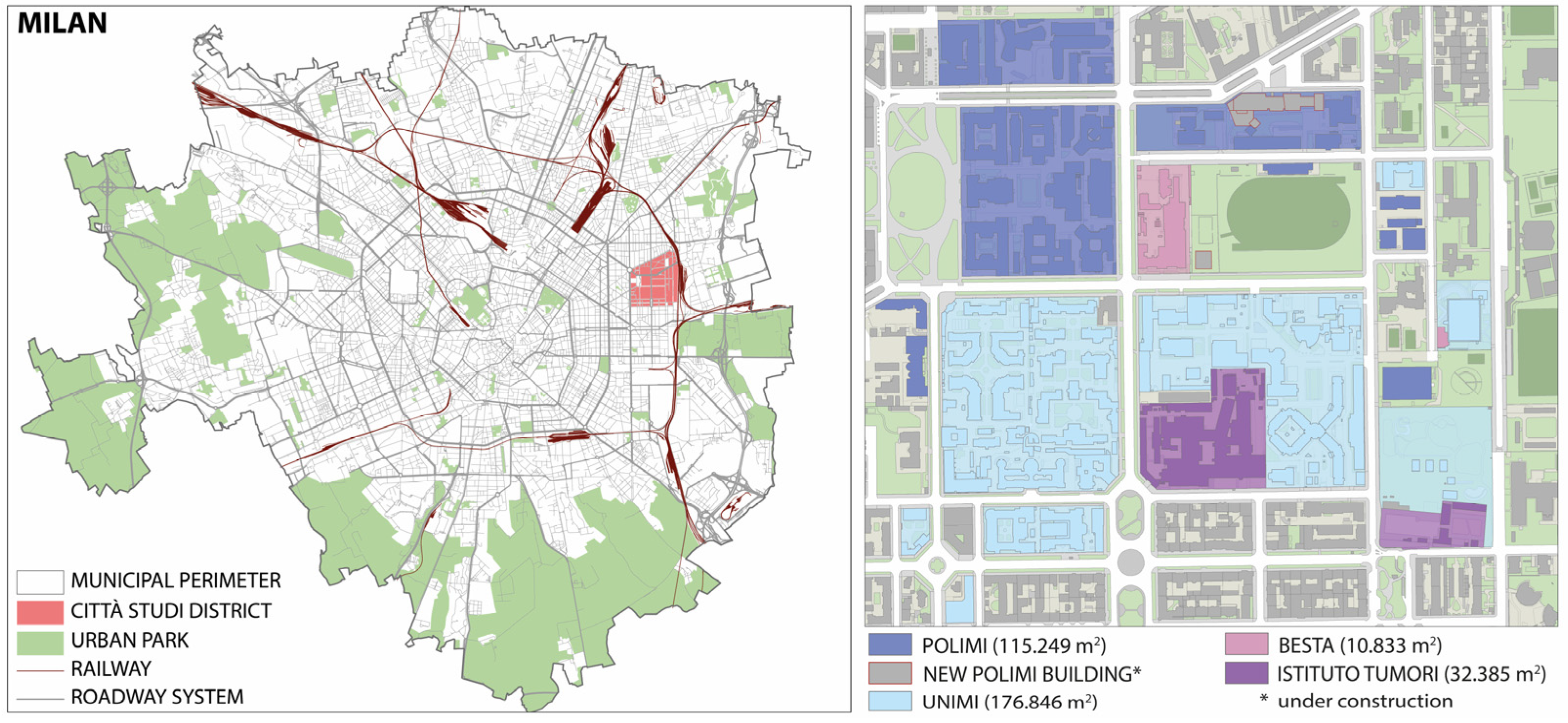

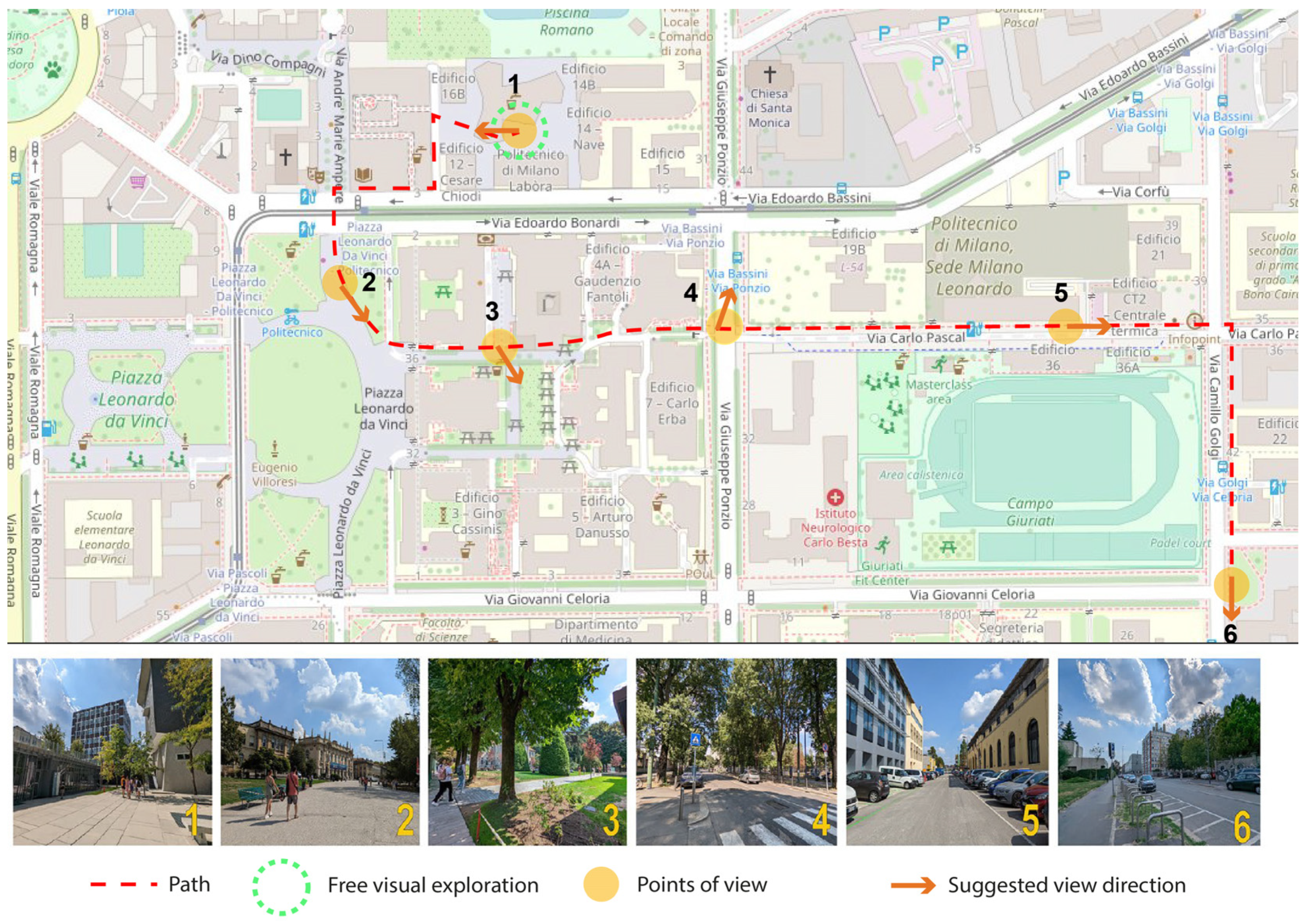






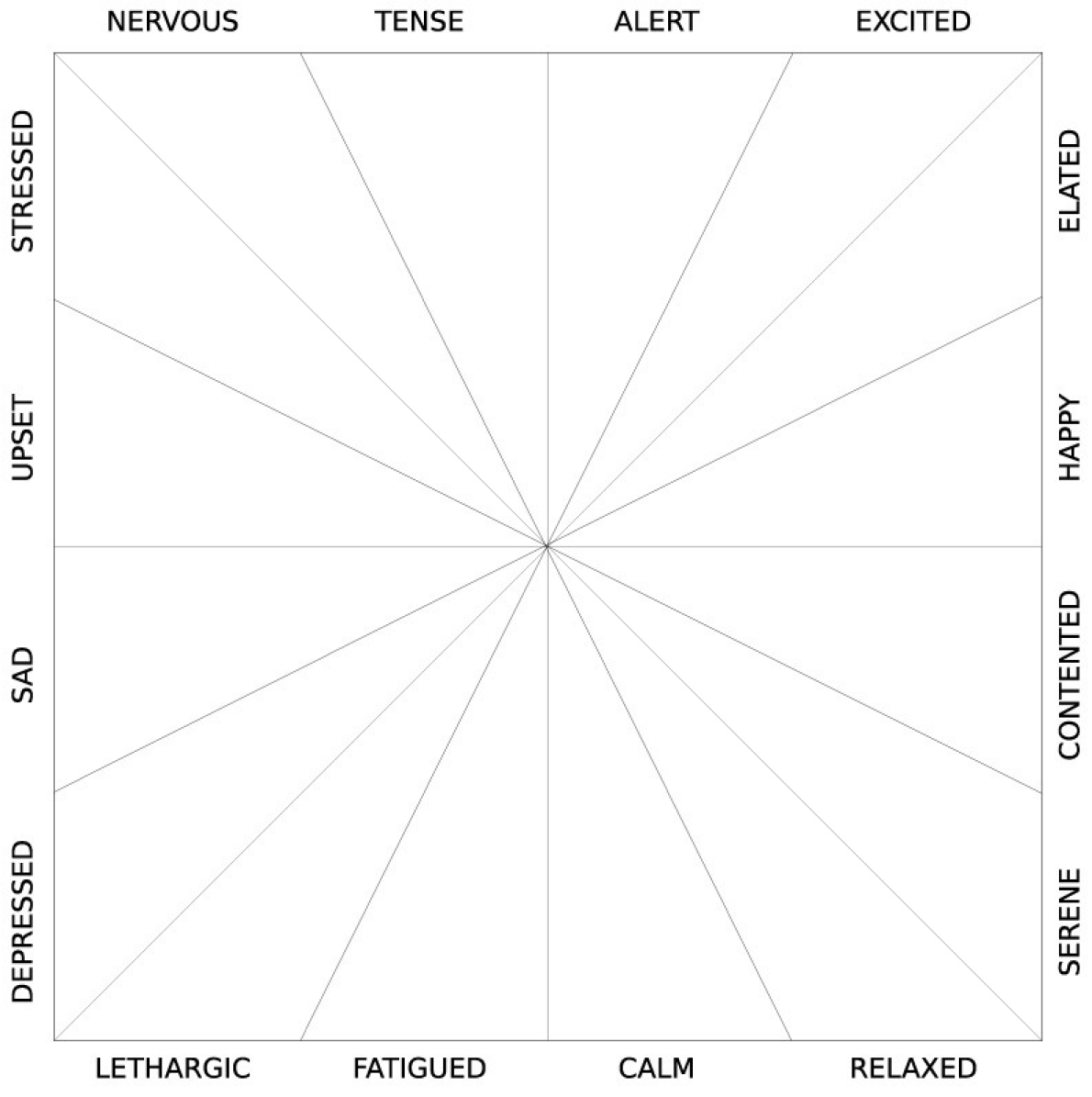
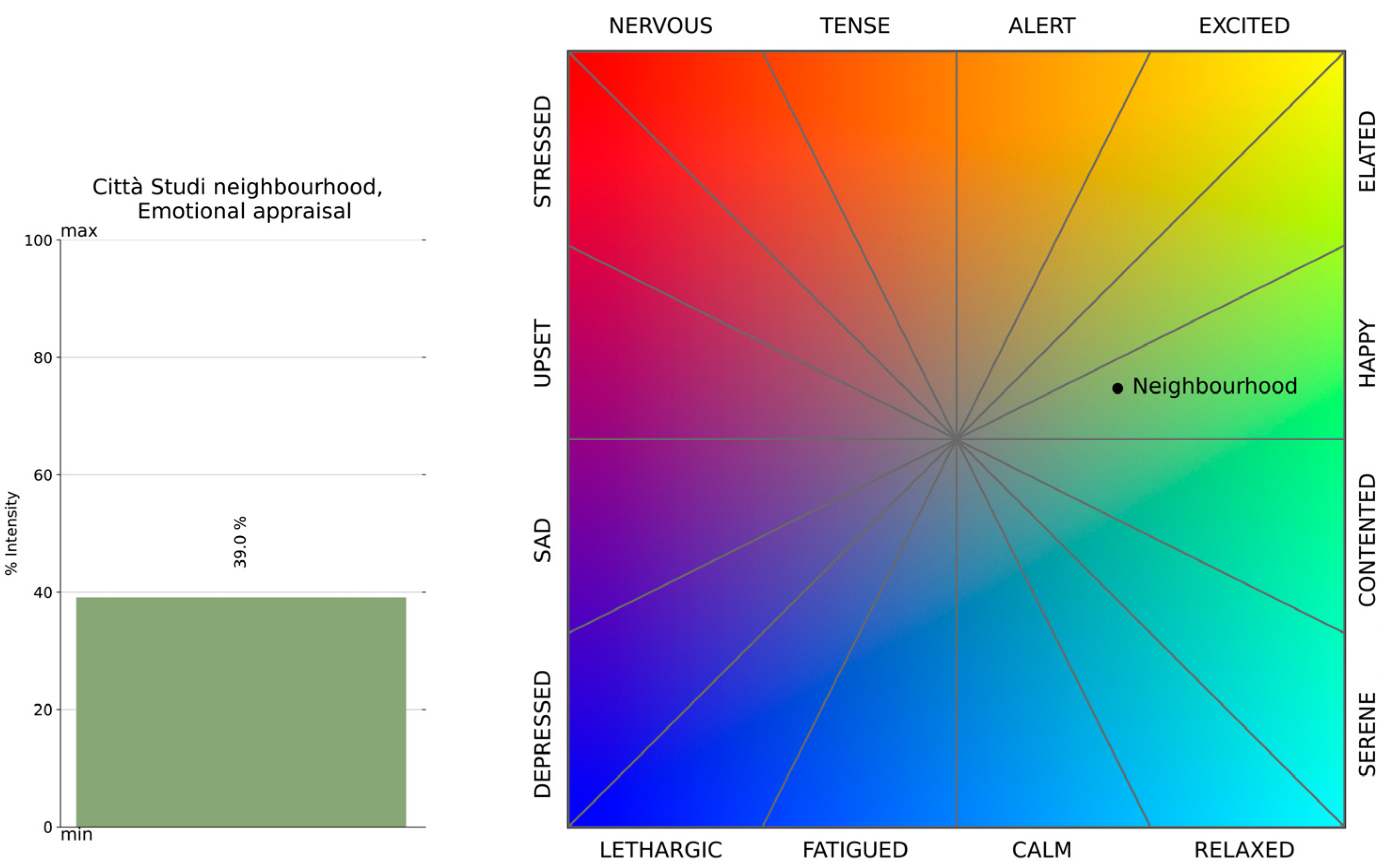


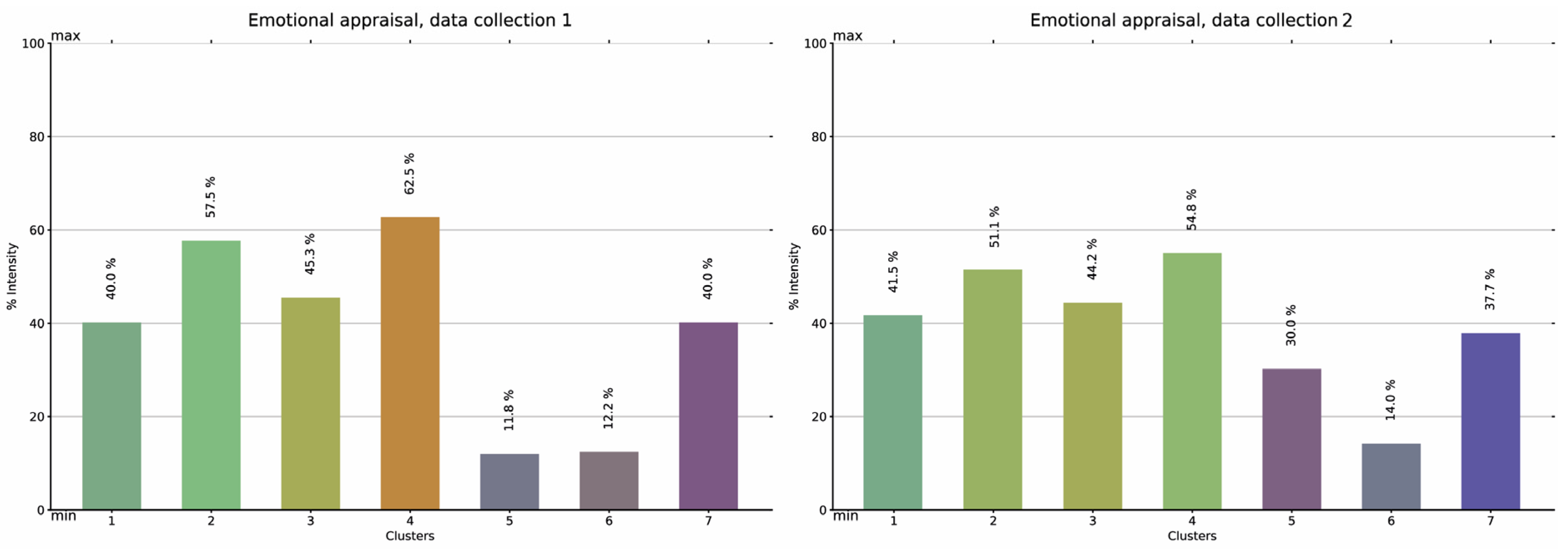


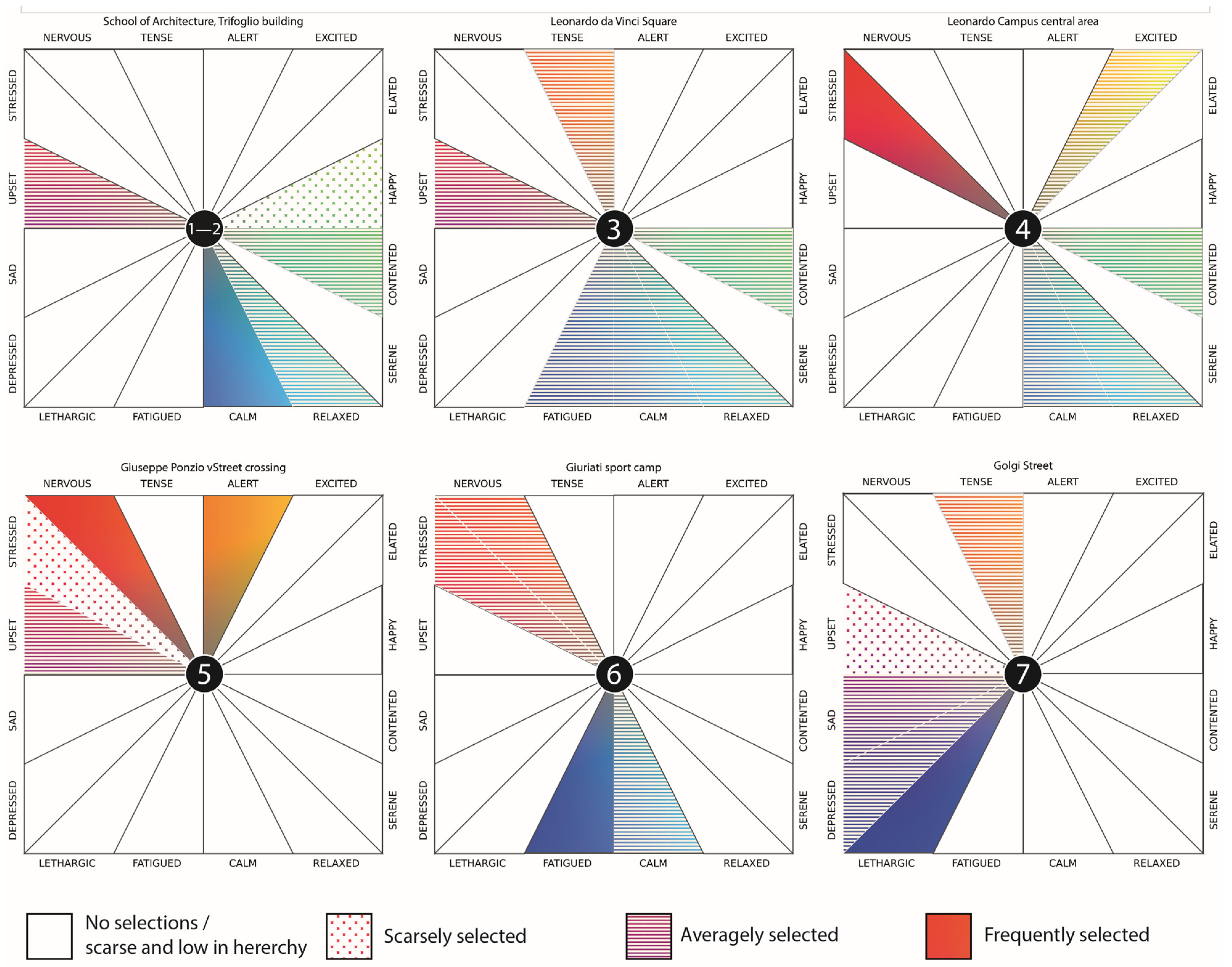


Disclaimer/Publisher’s Note: The statements, opinions and data contained in all publications are solely those of the individual author(s) and contributor(s) and not of MDPI and/or the editor(s). MDPI and/or the editor(s) disclaim responsibility for any injury to people or property resulting from any ideas, methods, instructions or products referred to in the content. |
© 2023 by the authors. Licensee MDPI, Basel, Switzerland. This article is an open access article distributed under the terms and conditions of the Creative Commons Attribution (CC BY) license (https://creativecommons.org/licenses/by/4.0/).
Share and Cite
Piga, B.E.A.; Rainisio, N.; Stancato, G.; Boffi, M. Mapping the In-Motion Emotional Urban Experiences: An Evidence-Based Method. Sustainability 2023, 15, 7963. https://doi.org/10.3390/su15107963
Piga BEA, Rainisio N, Stancato G, Boffi M. Mapping the In-Motion Emotional Urban Experiences: An Evidence-Based Method. Sustainability. 2023; 15(10):7963. https://doi.org/10.3390/su15107963
Chicago/Turabian StylePiga, Barbara Ester Adele, Nicola Rainisio, Gabriele Stancato, and Marco Boffi. 2023. "Mapping the In-Motion Emotional Urban Experiences: An Evidence-Based Method" Sustainability 15, no. 10: 7963. https://doi.org/10.3390/su15107963
APA StylePiga, B. E. A., Rainisio, N., Stancato, G., & Boffi, M. (2023). Mapping the In-Motion Emotional Urban Experiences: An Evidence-Based Method. Sustainability, 15(10), 7963. https://doi.org/10.3390/su15107963









